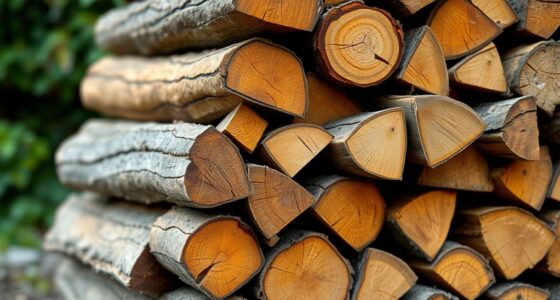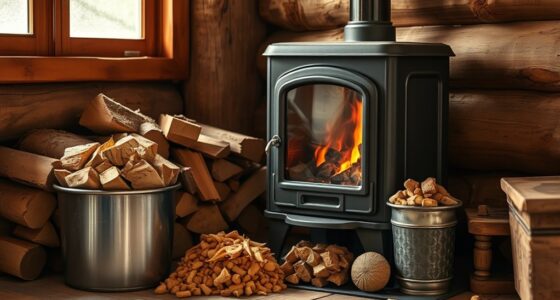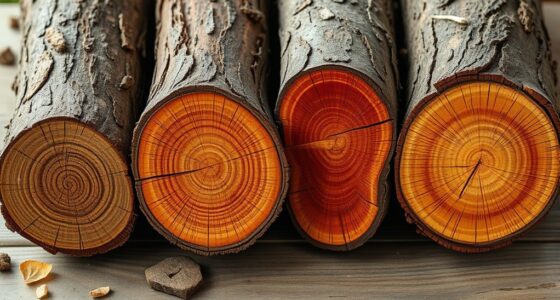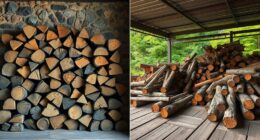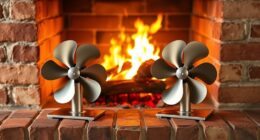Kiln-dried firewood has a moisture content below 20%, making it burn cleaner, hotter, and more consistently than air-dried wood, which usually contains 20-30% moisture. Kiln drying uses controlled heat to quickly and effectively remove excess moisture, while air drying takes months or years outdoors. If you want hassle-free, efficient heating with less smoke and creosote buildup, kiln-dried wood is the way to go. Keep going to learn even more about their differences.
Key Takeaways
- Kiln-dried firewood has moisture content below 20%, ensuring more efficient and cleaner burns compared to air-dried wood.
- Air-dried wood typically contains 20-30% moisture, which may lead to less uniform burning and more smoke.
- Kiln drying rapidly reduces moisture, while air drying relies on natural evaporation over months or years.
- Kiln-dried wood is less prone to reabsorption of moisture during storage, maintaining consistent burn quality.
- Proper storage is essential for both types, but kiln-dried wood generally requires less careful handling to preserve its low moisture content.
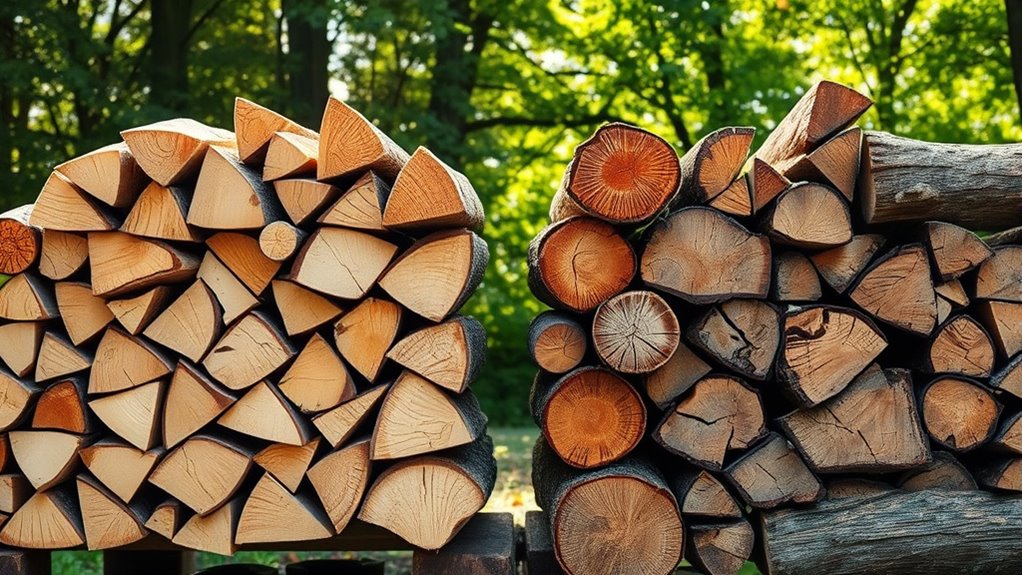
When choosing firewood, understanding the differences between kiln-dried and air-dried options can make a big impact on your heating experience. The key factor that influences how well your fire burns, how efficiently it produces heat, and how long it lasts is moisture content. Kiln-dried firewood typically has a moisture content below 20%, often around 15%, thanks to controlled heating processes that remove excess moisture rapidly. In contrast, air-dried firewood usually has a higher moisture content, ranging from 20% to 30%, because it relies on natural drying over several months or even years. This difference considerably affects how your fire performs, so knowing which type suits your needs can save you time, money, and frustration.
Storage methods play a crucial role in maintaining the quality of your firewood, regardless of its drying method. Kiln-dried wood is often sold in tightly sealed packaging or containers that help preserve its low moisture content during transport and storage. It’s designed to be ready for use immediately, but proper storage at home remains important to prevent it from reabsorbing moisture from the environment. You should keep kiln-dried wood in a dry, well-ventilated area, ideally off the ground and protected from rain or humidity. Conversely, air-dried firewood requires careful stacking outdoors or in a covered shed, with sufficient airflow around the logs to facilitate ongoing drying. Proper storage methods prevent moisture absorption, which can compromise burn quality and produce excess creosote buildup in your chimney.
Choosing between kiln-dried and air-dried firewood also hinges on how you plan to store it long-term. Kiln-dried wood, being more uniform and lower in moisture, typically doesn’t need as much space or elaborate storage, but it still benefits from being kept in a dry environment. Air-dried wood, which naturally contains more moisture, needs more attention during storage to avoid rehumidification. If you’re after convenience, kiln-dried wood offers the advantage of immediate use, with less concern about storage issues. Additionally, innovations in automation technology are making it easier to monitor and control moisture levels during storage. Proper ventilation and moisture control techniques can further extend the quality and lifespan of stored firewood, regardless of drying method. Understanding the moisture content and how it impacts burning efficiency is essential for selecting the best drying method for your needs.
Frequently Asked Questions
How Long Does Kiln-Dried Firewood Typically Last in Storage?
Kiln-dried firewood typically lasts up to 12-18 months in storage if kept in a dry, well-ventilated area. Its moisture stability is higher than air-dried wood, which means it resists mold and decay longer. To maximize storage duration, you should keep it off the ground and covered from rain. Properly stored kiln-dried firewood remains dry and ready for use, ensuring efficient burning and less trouble over time.
Can Air-Dried Firewood Be Used Immediately After Cutting?
Yes, you can use air-dried firewood immediately after cutting, but it’s better to allow it to season first. Proper seasoning time typically takes 6 to 12 months, depending on storage conditions like humidity and airflow. If you skip seasoning, the wood may be difficult to burn and produce more smoke. To get the best performance, stack your firewood in a well-ventilated area, and wait for it to reach ideal dryness.
Is There a Significant Cost Difference Between Kiln-Dried and Air-Dried Firewood?
You’ll find that kiln-dried firewood generally costs more than air-dried because of the energy and equipment involved in the drying process. The cost comparison shows significant price differences, often making kiln-dried wood pricier upfront. However, it’s more convenient and ready to burn, which might save you money in the long run. Consider your budget and needs when choosing between the two to make the best investment.
How Does Moisture Content Affect the Burning Efficiency of Firewood?
Think of moisture levels as the silent thief of warmth; high moisture content hampers your fire’s combustion efficiency. When firewood is too wet, it produces more smoke and less heat, similar to trying to burn soggy paper. To maximize burning efficiency, keep moisture content low—ideally below 20%. Properly dried firewood guarantees a cleaner, hotter, and more efficient burn, transforming your fire from a flicker to a roaring blaze.
Are There Specific Wood Species Better Suited for Kiln-Drying?
Certain hardwood species, like oak, hickory, and maple, are better suited for kiln-drying because they have dense, moisture-retentive properties that benefit from controlled drying. Softwoods, such as pine or spruce, also respond well to kiln-drying, making them suitable for quick-burning needs. You’ll find that kiln-drying enhances their burn quality, reduces creosote buildup, and ensures consistent moisture levels across different wood types.
Conclusion
Choosing between kiln-dried and air-dried firewood is like selecting the perfect brushstroke for your fire’s masterpiece. Kiln-dried wood offers a precise, fiery dance with instant ignition, while air-dried wood whispers slow, smoky secrets from the past. Your ultimate choice depends on how you want your flames to flicker—quick and bright or slow and soulful. Whichever you pick, remember, the right wood turns your fire into a warm, glowing symphony.




